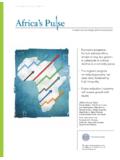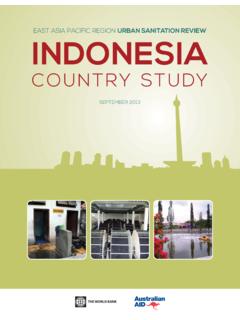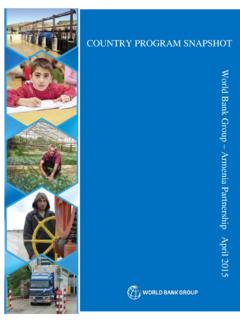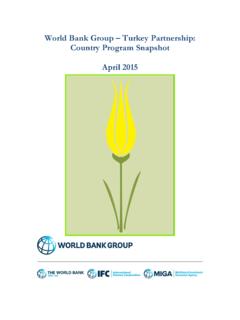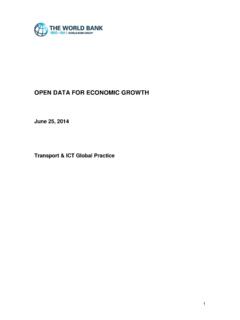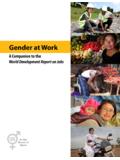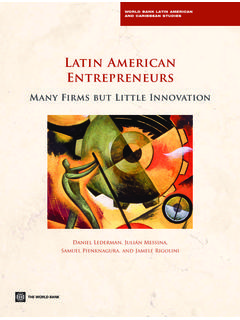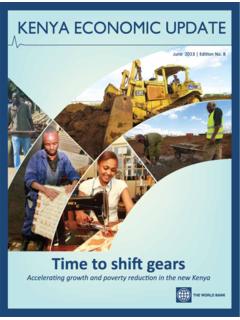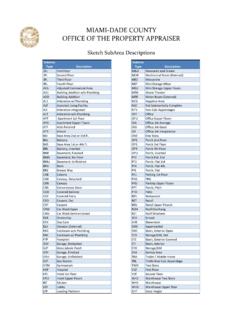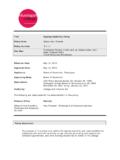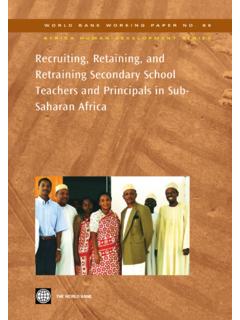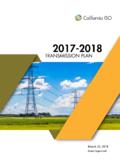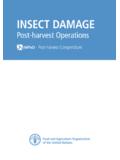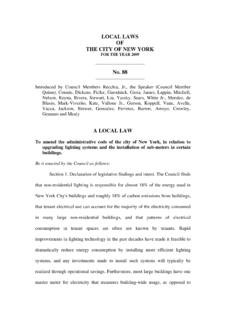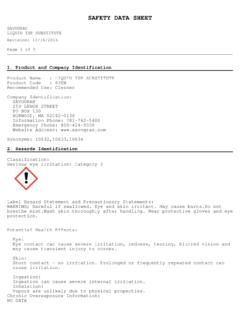Transcription of SUB-SAHARAN AFRICA - World Bank Group
1 1 Recent Developments GDP growth in SUB-SAHARAN AFRICA improved to an average of percent in 2014, up from percent in 2013, but weaker than the average of percent during 2002 08, supported by infrastructure in-vestment and consumer spending. Growth softened around the turn of the year owing to headwinds from the plunge in the price of oil. SUB-SAHARAN AFRICA s oil exporters, which account for nearly half of the region s GDP, are experiencing a major ad-verse shock1. Their economies depend heavily on oil for revenues and foreign reserves (Figure ). Between June 2014 and January 2015, oil prices de-clined by nearly 50 percent, more than the prices of other commodities, and have remained low despite the recent uptick (Figure ).
2 This has put sub-stantial pressures on the fiscal and current account balances of oil oil exporters in SUB-SAHARAN AFRICA are less resil-ient to the price shock than many other oil-exporting countries because of their much more limited policy buffers. In Nigeria, the Excess Crude Account, a sov-ereign wealth fund, totaled just $ billion at the end of 2014. Gross international reserves fell 20 per- SUB-SAHARAN AFRICAGDP growth in SUB-SAHARAN AFRICA rose from percent in 2013 to in 2014, supported by domestic de-mand. The World bank forecast has the region expanding at a slower pace in 2015, with growth averaging percent, a downward revision of percent relative to the January 2015 Global Economic Prospects (GEP).
3 Prospects in Angola and Nigeria have deteriorated because of the sharp drop in the price of oil, and in South AFRICA because of the ongoing difficulty in overcoming electricity problems. Risks to the outlook remain tilted to the downside. On the domestic front, risks associated with elections, the Boko Haram insurgency, the Ebola crisis, and fiscal vulnerabilities dominate. China s slowdown, tightening of monetary policy in the United States, and the fragility of the recovery in Europe, remain as key external risks. IBRD 41132 SEPTEMBER 2014 The main author of this section is Gerard region s main oil exporters include Angola, Cameroon, Congo (Republic), Chad, Equatorial Guinea, Gabon, and Nigeria.
4 Of these, Nigeria and Angola are the largest; they are also the region s first and third largest : IMF Country reports. Note: Latest available from latest IMF Article IV Fiscal vulnerabilityOil accounts for up to 90 percent of fiscal revenues for the region s oil GuineaCongo, , Dem. aspercent of fiscal revenues cent to $ billion ( percent of GDP), drawn down by the central bank in its attempt to support the naira. In March, Standard & Poor s downgraded Nigeria s credit rating from B+ to BB-. Several of the region s oil exporters have started to adjust. In Angola, the oil price assumption in the 2015 budget was revised down to $40/bbl from the original assumption of $81/bbl.
5 In Nigeria, it was reduced to US$53/bbl from the earlier forecast of $65/barrel. The corresponding downward revision in expected revenues induced plans to cut public spending. In Angola, Parliament approved a 25 per-cent reduction in spending from the original plan for 2015. The cuts cover public investment projects Chapter 2 GLOBaL eCONOMIC prOSpeCtS | JUNe 2015 2and current expenditures, including subsidies. In Nigeria, the 2015 federal government budget passed by the Senate indicates sharp reductions in capital expenditures. With the lower government spending, the non-oil economy in many of these countries is faltering, especially in the least diversified economies (Angola and Equatorial Guinea).
6 Nigeria s non-oil output growth slowed to percent in year-on-year terms in the first quarter of 2015, down from percent in the fourth quarter of 2014. Sharp currency depreciations, and foreign reserve losses, prompted adjustments in monetary and exchange rate policies. The Central bank of Nige-ria raised the policy rate from 12 to 13 percent in November. However, with oil prices declining, the naira continued to depreciate against the dol-lar. The overall depreciation between June 2014 and February 2015 was more than 20 percent (Figure ). In response, the central bank ended its man-aged float exchange-rate regime, closing down the Dutch Auction System window.
7 The exchange rate is now set in the interbank market. The naira re-bounded in March and was stable through April, as successful elections helped improve market senti-ment, but remained weak (Figure ). In Angola, the central bank hiked its key interest rate by 50 basis points, to 9 percent, in the fourth quarter, to anchor inflation expectations. Following a gradual weakening of the Angolan kwanza, in early June, the central bank adjusted the official exchange rate, leaving the kwanza 14 percent weaker than at the start of 2015. Several of the region s oil export-ers (Cameroon, Chad, Congo Republic, Equatorial Guinea, and Gabon) share a common currency, the CFA franc, which is pegged to the euro.
8 With the euro depreciating against the dollar, the CFA franc has also depreciated against the dollar. This has helped smooth adjustment to the oil-price shock for these countries, by boosting export earnings in do-mestic currency. In contrast to oil exporters, the oil-price plunge has provided cyclical support to real incomes in oil-importing countries. Cheaper fuel helped lower inflation and improve current accounts in the first quarter of 2015. In Kenya and South AFRICA , infla-tion rates moved back within their target range, al-lowing central banks to keep interest rates steady. By contrast, the naira devaluation added to price pressures in Nigeria, while Ghana continued to bat-tle double-digit inflation, at percent in April (Figure ).
9 Against the broad-based strength of the dollar, even the currencies of oil- importing countries faced downward pressures, with, for example, the Zambian kwacha falling sharply. In trade-weighted terms, most of the re-gion s currencies have remained broadly stable, with the exception of the naira and the Ghanaian cedi (Figure ). Despite the nominal deprecia-tion against the dollar the naira has appreci-ated considerably in real effective terms since 2011, which may hurt in South AFRICA , the region s largest oil- importing economy, was stronger than expected in the fourth quarter of 2014, supported by a rebound in the goods-producing sectors, after slowing earlier in the year.
10 This rebound failed to carry into the first Source: World Commodity pricesSince June 2014 oil prices have declined by more than 40 percent. -50-40-30-20-100 OilNatural gasIron oreCopperGoldPlatinumCoffeeCocoaTeaPerce nt changeof nominal indices, 2010=100, June 2014 April 2015 Source: Bloomberg. Note: Decrease denotes "depreciation".FIguRe Nigerian nairaOil prices continue to weigh on the Nigerian exchange rate against US$Crude oil price (RHS)LCU/US$US$ per barrelChapter 2 | SUB-SAHARAN aFrICaGLOBaL eCONOMIC prOSpeCtS | JUNe 2015 3quarter of 2015, however. Growth was held back by energy shortages, output contraction in agriculture, weak investor confidence, policy uncertainty, and the anticipated gradual tightening of monetary and fiscal policy.

